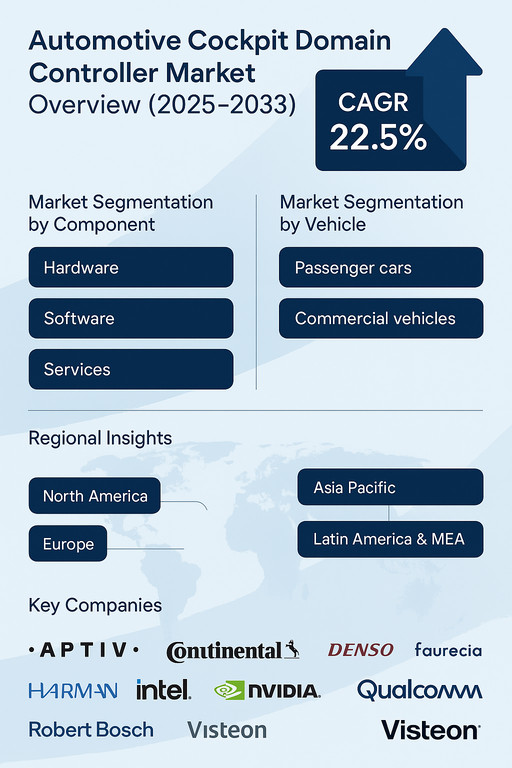The global automotive cockpit domain controller market is projected to grow at a CAGR of 22.5% from 2025 to 2033, driven by rapid advancements in in-vehicle electronics, rising demand for digital cockpit systems, and the transition toward software-defined vehicles. Cockpit domain controllers consolidate multiple functions such as infotainment, instrument clusters, connectivity, driver assistance, and head-up displays into a centralized computing unit. This approach reduces hardware complexity, lowers costs, and enhances vehicle performance, while supporting over-the-air (OTA) updates and seamless integration of advanced driver-assistance systems (ADAS).

Rising Demand for Centralized Vehicle Architectures
The shift from distributed electronic control units (ECUs) to centralized domain controllers is fueling strong adoption in passenger and commercial vehicles. Modern consumers increasingly demand advanced in-car experiences such as AI-driven infotainment, real-time navigation, and personalized digital assistants. At the same time, automakers are moving toward domain and zonal architectures to reduce wiring complexity and improve vehicle energy efficiency. As EV penetration grows, cockpit domain controllers are becoming central to ensuring connectivity, safety, and driver experience.
Challenges: Integration Complexity and Cybersecurity Risks
Despite significant growth, the market faces challenges such as the high complexity of integrating cockpit domain controllers with existing vehicle platforms. Automakers must ensure compatibility with legacy systems and diverse hardware suppliers, which increases development costs and timelines. Cybersecurity risks also pose a major challenge, as cockpit domain controllers manage critical vehicle functions and passenger data. Strict regulatory requirements for automotive safety and data protection add to compliance costs. However, ongoing innovation in automotive-grade semiconductors, AI integration, and secure operating systems is expected to mitigate these risks.
Market Segmentation by Component
By component, the market is segmented into hardware, software, and services. Hardware currently dominates due to the high demand for domain controller units, processors, and chipsets. However, software is the fastest-growing segment, fueled by the need for operating systems, middleware, and user interface solutions that enable advanced cockpit functionalities. Services, including integration, maintenance, and OTA updates, are also gaining importance as automakers seek long-term partnerships with technology providers.
Market Segmentation by Vehicle
By vehicle type, the market is divided into passenger cars and commercial vehicles. Passenger cars hold the largest share, supported by growing consumer demand for connected and personalized in-car experiences, particularly in premium and electric vehicles. Commercial vehicles are expected to show strong growth, driven by the integration of cockpit domain controllers in trucks and buses for fleet management, telematics, and advanced safety monitoring.
Regional Insights
In 2024, Asia Pacific led the automotive cockpit domain controller market, driven by strong vehicle production, rapid adoption of EVs, and rising investments in intelligent cockpit technologies in China, Japan, and South Korea. Europe followed, supported by strict regulations on vehicle safety, high adoption of premium cars, and strong innovation in automotive electronics. North America remains a key market, led by the U.S., where automakers and tech companies collaborate on next-generation cockpit platforms. Latin America and Middle East & Africa (MEA) are emerging regions, gradually adopting cockpit domain controllers with growing vehicle digitization and connectivity initiatives.
Competitive Landscape
The 2024 market was shaped by leading automotive technology suppliers and semiconductor companies. Aptiv, Continental, and Bosch remain key players offering integrated cockpit domain controller solutions with strong OEM partnerships. Visteon and Faurecia specialize in digital cockpit design and integration, focusing on user experience and modular architectures. HARMAN, a Samsung company, leverages its infotainment expertise to lead in connected cockpit solutions. Semiconductor giants Intel, NVIDIA, and Qualcomm Technologies play a critical role, providing high-performance processors and AI platforms that enable advanced cockpit functionalities. Denso further strengthens the market with its deep automotive system integration capabilities. Competitive strategies focus on collaborations with OEMs, AI and software innovation, and scaling domain controllers for mass-market vehicles.
Historical & Forecast Period
This study report represents analysis of each segment from 2023 to 2033 considering 2024 as the base year. Compounded Annual Growth Rate (CAGR) for each of the respective segments estimated for the forecast period of 2025 to 2033.
The current report comprises of quantitative market estimations for each micro market for every geographical region and qualitative market analysis such as micro and macro environment analysis, market trends, competitive intelligence, segment analysis, porters five force model, top winning strategies, top investment markets, emerging trends and technological analysis, case studies, strategic conclusions and recommendations and other key market insights.
Research Methodology
The complete research study was conducted in three phases, namely: secondary research, primary research, and expert panel review. key data point that enables the estimation of Automotive Cockpit Domain Controller market are as follows:
Market forecast was performed through proprietary software that analyzes various qualitative and quantitative factors. Growth rate and CAGR were estimated through intensive secondary and primary research. Data triangulation across various data points provides accuracy across various analyzed market segments in the report. Application of both top down and bottom-up approach for validation of market estimation assures logical, methodical and mathematical consistency of the quantitative data.
| ATTRIBUTE | DETAILS |
|---|---|
| Research Period | 2023-2033 |
| Base Year | 2024 |
| Forecast Period | 2025-2033 |
| Historical Year | 2023 |
| Unit | USD Million |
| Segmentation | |
Component
| |
Vehicle
| |
Technology
| |
Sales Channel
| |
Application
| |
|
Region Segment (2023-2033; US$ Million)
|
Key questions answered in this report